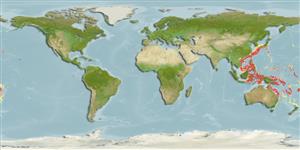Actinopterygii (peixes com raios nas barbatanas) >
Ophidiiformes (Cusk eels) >
Ophidiidae (Cusk-eels) > Neobythitinae
Etymology: Neobythites: Greek, neos = new + Greek, bythitis, -idos = it is at the bottom, sunken (Ref. 45335). More on author: Smith.
Ambiente / Clima / Intervalo
Ecologia
; marinhas bentopelágico; intervalo de profundidade 110 - 567 m (Ref. 95664). Deep-water, preferred ?
Western Pacific: Japan to the Philippines, off New Caledonia and the Arafura Sea.
Tamanho / Peso / Idade
Maturity: Lm ? range ? - ? cm
Max length : 23.2 cm SL macho/indeterminado; (Ref. 95664)
Raios dorsais moles (total): 90-92; Raios anais moles: 74 - 75; Vértebras: 53 - 54. Distinct ocellus on dorsal fin situated immediately behind vertical line through anus, two sharp spines on posterior margin of preoperculum, ventral fins reaching halfway to anus and no vertical bars on body.
A benthic species found on the continental shelf and slope (Ref. 75154). Uncommon species (Ref. 34024). Oviparous, with oval pelagic eggs floating in a gelatinous mass (Ref. 205).
Life cycle and mating behavior
Maturidade | Reprodução | Desova | Ovos | Fecundidade | Larvas
Nielsen, J.G., D.M. Cohen, D.F. Markle and C.R. Robins, 1999. Ophidiiform fishes of the world (Order Ophidiiformes). An annotated and illustrated catalogue of pearlfishes, cusk-eels, brotulas and other ophidiiform fishes known to date. FAO Fish. Synop. 125(18):178p. Rome: FAO. (Ref. 34024)
Categoria na Lista Vermelha da IUCN (Ref. 115185)
CITES (Ref. 94142)
Not Evaluated
Ameaça para o homem
Harmless
Utilização humana
Mais informação
ReferênciasAquaculturaPerfil para aquaculturaEstirpesGenéticaFrequência dos alelosHereditariedadeDoençasProcessamentoMass conversion
Ferramentas
Relatórios especiais
Descarregue XML
Fontes da internet
